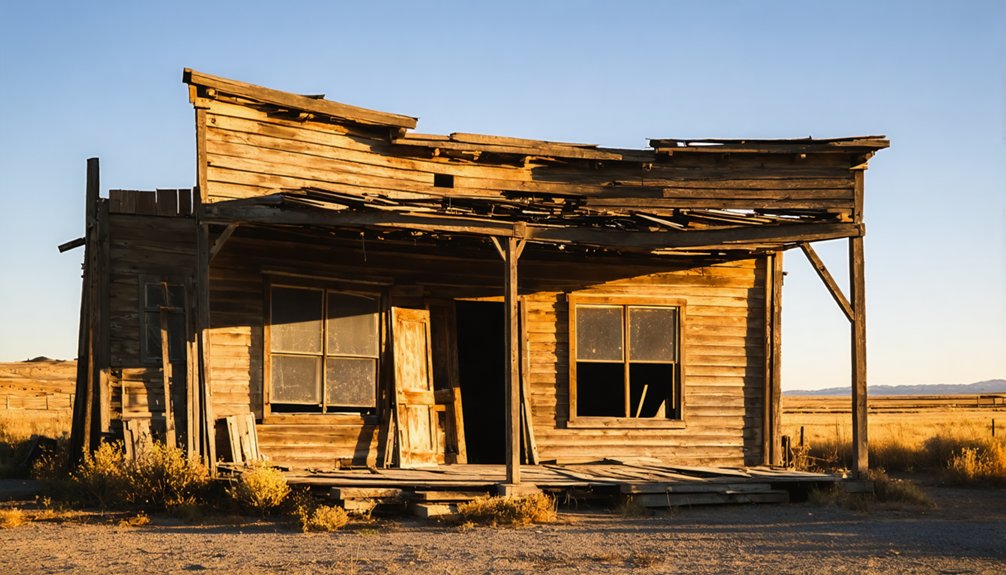You’ll find Banner ghost town perched at 8,200 feet in Idaho’s Boise National Forest, where silver discoveries in 1864 sparked a mining rush that produced nearly $3 million in wealth. The town flourished with stamp mills, boarding houses, and a post office until operations ceased in 1921. Today, you can explore deteriorating log cabins, collapsed mine entrances, and remnants of rail infrastructure amid the rugged mountain landscape. This remote historic site reveals deeper layers of Idaho’s mining heritage.
Key Takeaways
- Banner was a thriving silver mining town established in 1864 that produced nearly $3 million worth of silver before closing in 1921.
- Located at 8,200 feet elevation, the ghost town is accessible only from July to October via jeep trails and dirt roads.
- Remnants include deteriorating log cabins, a collapsed mine entrance, and an old stamp mill site where silver ore processing occurred.
- The town operated a post office from 1878 to 1913 and featured informal gathering places like boarding houses and saloons.
- Visitors can find the site at coordinates 43° 59.00′ N, 115° 32.92′ W, but should prepare for remote conditions with water and proper footwear.
The Silver Rush That Built a Town
While gold initially drew prospectors to Idaho’s Crooked River placers in 1863, the discovery of silver lodes in Banner on July 6, 1864, would transform the region.
Prospectors Bradford and Carr traced these silver deposits from the original Rocker Diggings, where both gold and silver had been found.
You’ll find that the silver discovery didn’t create an immediate rush – many prospectors were initially distracted by other opportunities like the Payette rush.
But when high assay results came back in August 1864, everything changed. Within weeks, 200 prospectors flooded the area, establishing about fifty new ledges.
The towns of Banner and Eureka sprang up simultaneously, with 120 miners settling in, ready to face the mining challenges of extracting silver from lead-rich ores in veins two to eight feet wide. Development continued through harsh winter conditions as miners established their 300-foot tunnel operations.
Like many mining towns of the era, Banner would eventually face environmental consequences, with contaminated soil affecting the surrounding landscape.
Mining Operations and Economic Prosperity
Although Banner’s early miners relied on basic placer techniques in 1864, the district quickly evolved into a sophisticated operation worth nearly $3 million in silver production.
From simple beginnings in 1864, Banner’s mining district transformed into a sophisticated silver operation generating millions in revenue.
You’ll find that mining techniques progressed from simple arastras to advanced stamp mills after G.W. Craft’s 1874 modernization, revolutionizing ore processing capabilities.
The economic impact rippled through Banner and Eureka, supporting not just miners but also merchants and service providers.
When Elmira investors arrived in 1878, they injected vital capital that funded deeper mine development and better technology.
While initial excitement drew 200+ prospectors, the workforce stabilized at 120 miners who focused on the consistently profitable Banner ledge.
Despite discovering fifty new silver ledges, only the original Banner mine maintained long-term viability, operating successfully until declining ore grades forced closure in 1921.
The mine’s significance is evident in its classification as a significant deposit size according to historical records.
Life in Banner’s Heyday
During Banner’s peak years, you’d find a small but resilient community centered around the profitable silver mines, with miners and their families occupying simple cabins near the mining operations.
Life revolved around the rhythms of mining work, with daily routines shaped by the harsh mountain environment and limited amenities. Like many other settlements during the 1860s gold rush, Banner emerged as prospectors sought their fortunes in Idaho’s mineral-rich mountains.
The arid climate helped preserve many of the original mining structures that remained after the town’s decline. You’d discover a frontier town connected to the outside world by rough mining roads leading north from Idaho City. The post office, operating between 1878 and 1913, served as an essential link to civilization.
Community gatherings likely took place in informal venues like boarding houses or saloons, where miners could unwind after long shifts.
While Banner lacked formal institutions like schools or churches, residents forged strong bonds through their shared experiences and mutual reliance in this remote mountain setting.
What Remains: A Journey Through Time
As you explore Banner today, you’ll find scattered remnants of its mining heritage amid the reclaimed mountain landscape.
While the site’s historical significance remains evident, nature has steadily reclaimed much of what civilization built here.
The Elmira Silver Mining Company operations generated over three million dollars in silver bullion during the town’s peak.
Your journey through Banner’s remains will reveal:
- Original log cabins still standing, though most structures show heavy deterioration
- The identifiable stamp mill site where silver ore processing once flourished
- A mine entrance with collapsed rail infrastructure, now flooded and overgrown
- Remnants of a bunkhouse where miners once lived and gathered
Poor road conditions and washouts make accessing many of the historical sites challenging.
Without formal preservation efforts, these traces of Banner’s past continue to fade.
The absence of artifacts, museums, or interpretive signage leaves visitors to piece together the town’s story through weathered foundations and historical documents.
Planning Your Visit to Banner’s Historic Sites
Ready to explore Banner’s historic ghost town? You’ll need to navigate a network of jeep trails and dirt roads leading to this remote mining site.
Start by marking key GPS coordinates (43° 59.00′ N, 115° 32.92′ W) to guarantee you don’t miss critical turns along the access routes.
For the best travel tips, pack plenty of water and wear sturdy hiking boots – you’ll encounter gates that require walking portions of the trail. Remember to clean up after yourself and carry out any trash to help preserve this historic site.
If you’re planning to cross the North Fork of the Boise River, check seasonal water levels first. The nearby Jackson Peak Lookout, standing at 8,124 feet, offers spectacular views worth the trek.
While few original structures remain intact, you’ll discover fascinating remnants of Banner’s silver mining era scattered throughout the rugged terrain. Due to the high elevation at 8,200 feet, visits are only possible during the mid-July to October window.
Frequently Asked Questions
Were There Any Notable Crimes or Lawlessness During Banner’s Peak Mining Years?
Where there’s smoke, there’s fire – you’ll find that while mining disputes occurred, detailed records of outlaw gangs or major crimes aren’t well-documented during Banner’s bustling silver mining peak years.
What Happened to the Descendants of Banner’s Original Mining Families?
You’ll find modern descendants scattered across Idaho cities like Boise and beyond to Midwest states, with family legacies preserved through historical societies, though most left mining for other industries.
Did Native American Tribes Have Any Significant Interactions With Banner’s Settlers?
Isn’t it telling that you won’t find records of cultural exchanges between Banner’s settlers and local tribes? While Native Americans lived nearby, there’s no evidence of trade relations or significant interactions.
Were There Any Major Accidents or Disasters in Banner’s Mining Operations?
You’ll find few specific accident reports from Banner’s mines, though the region witnessed major disasters like the 1972 Sunshine Mine fire and 1973 Bunker Hill crisis’s devastating aftermath nearby.
What Animals and Wildlife Can Visitors Commonly Encounter Around Banner Today?
With Idaho’s 50,000+ black bears, you’ll find plenty of wildlife sightings around Banner. Watch for mule deer, moose, and raptors year-round, while keeping your distance to respect natural animal behavior.
References
- https://westernmininghistory.com/towns/idaho/banner/
- https://history.idaho.gov/wp-content/uploads/2018/08/0064.pdf
- https://idaho-forged.com/idahos-ghost-towns-eerie-yet-approachable/
- https://www.ghosttowns.com/states/id/banner.html
- https://history.idaho.gov/wp-content/uploads/0201.pdf
- https://www.youtube.com/watch?v=GwSHP92a6pU
- https://visitidaho.org/things-to-do/ghost-towns-mining-history/
- https://history.idaho.gov/wp-content/uploads/2018/12/0160.pdf
- https://npshistory.com/publications/blm/historic-mines-blaine-co.pdf
- https://www.youtube.com/watch?v=Au2IYj9jA00



